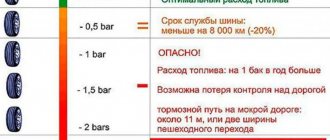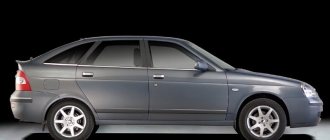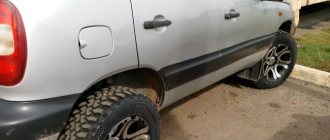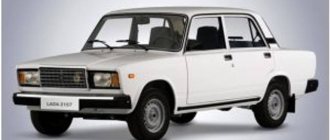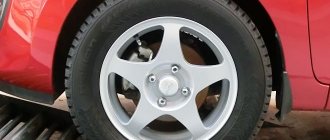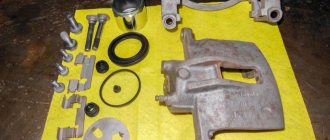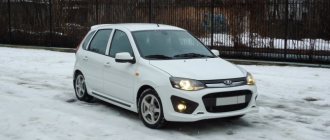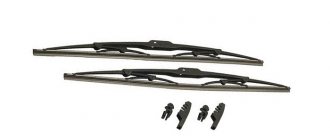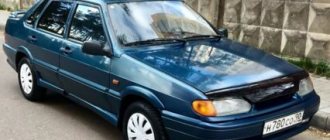VAZ 2108 piston size 8 valves
Depth of recesses for valves, on the piston bottom.
2110, eliminates the possibility of valves coming into contact with the piston if the timing belt breaks. The piston design of the 2110 and all subsequent models uses a loose fit piston pin. The clearance in the hole in the connecting rod head and in the holes in the piston ensures free rotation of the pin. The pin is secured in the axial direction with locking rings. For this purpose, the piston, in the pin holes, has installation grooves for retaining rings. On the outside of the piston pin holes, in the upper part, there are small recesses that make it easier to install and remove the circlips. In addition, they facilitate the access of oil to the contact area.
This design simplifies the assembly process and ensures uniform wear of rubbing surfaces, increasing the service life of parts. The piston diameter classes and piston pin hole classes adopted for model 21083 correspond to the classes of models 2110, 2112, 21124.
Basic casting markings applied to the part.
1. Product model designation – symbols “21” and “10”, in the area of the finger hole.
2. Designation, on the inside of the skirt.
3. Designation of casting equipment - letters and numbers, on the inside of the skirt.
4. The designation of the casting alloy is “AL34”, on the inside of the skirt.
Basic markings applied to the bottom.
1. Orientation marker - "
» during installation, must point towards the camshaft drive
2. Class marker - one of the symbols (“A”, “B”, “C”, “D”, “E”) determines the deviation in the outer diameter.
3. Piston mass group marker:
«
» – normal;
4. Piston pin hole class marker – one of the numbers (“1”, “2”, “3”) determines the deviation in the diameter of the piston pin hole.
The hole class marking is additionally applied with paint on the inside of the bottom:
Additionally, for repair pistons.
5. Marker for repair products:
«
» — 1st repair (diameter increased by 0.4 mm from the nominal size.)
«
» — 2nd repair (diameter increased by 0.8 mm from the nominal size.)
| PISTON | 21083-1004015 |
| Manufacturer | JSC AVTOVAZ |
| Piston diameter (nominal), mm: | 82,0 |
| Piston diameter (1st repair), mm: | 82,4 |
| Piston diameter (2nd repair), mm: | 82,8 |
| Weight, g: | 335,0 |
| Piston pin | 21213-1004020 |
| Piston pin diameter, mm: | 22 |
| Piston rings | 21083-1000100 |
| Ring height, mm: | 1,5/2,0/3,95 |
The depth of the recesses for the valves, on the bottom of the piston 21083, eliminates the possibility of the valves coming into contact with the piston if the timing belt breaks.
A design feature of the VAZ 21083 piston, which distinguishes it from the 2110 piston, is the method of fixing the piston pin. In the 21083 design, the piston pin (21213-1004020 or 2101-1004020) is pressed into the upper head of the connecting rod 2108-1004045. The tight fit defines the position of the finger and prevents it from moving. The diameter of the holes in the piston bosses provides the piston pin and connecting rod with free angular rotation. On the side surface, on the area near the hole for the piston pin, there are model markings - “21” and “083”. In terms of geometric parameters, there are no differences between the pistons of the VAZ 21083 and VAZ 2110 models.
Main Dimensions
| Piston class by outer diameter | A | B | C | D | E |
| Piston diameter 82.0 (mm) | 81,965-81,975 | 81,975-81,985 | 81,985-81,995 | 81,995-82,005 | 82,005-82,015 |
| Piston diameter 82.4 (mm) | 82,365-82,375 | 82,375-82,385 | 82,385-82,395 | 82,395-82,405 | 82,405-82,415 |
| Piston diameter 82.8 (mm) | 82,765-82,775 | 82,775-82,785 | 82,785-82,795 | 82,795-82,805 | 82,805-82,815 |
| Piston pin hole class | 1 | 2 | 3 |
| Piston pin hole diameter(mm) | 21,982-21,986 | 21,986-21,990 | 21,990-21,994 |
Applicability of piston 21083-1004015.
Source
Marking of ZMZ pistons
Another category of car owners interested in piston markings have ZMZ brand motors at their disposal. They are installed on GAZ cars - Volga, Gazelle, Sobol and others. Let's look at the symbols on their bodies.
The designation “406” means that the piston is intended for installation in the ZMZ-406 engine. There are two markings stamped on the piston crown. According to the letter painted on the new block, the piston is matched to the cylinder. When repairing with cylinder boring, the required clearances are made during the process of boring and honing for pre-purchased pistons with the required size.
The Roman numeral on the piston indicates the correct piston pin group. The diameters of the holes in the piston bosses, the connecting rod head, as well as the outer diameters of the piston pin are divided into four groups, marked with paint: I - white, II - green, III - yellow, IV - red. On the fingers, the group number is also marked with paint on the inner surface or on the ends. It must match the group indicated on the piston.
The group number should similarly be marked with paint directly on the connecting rod. In this case, the mentioned number must either coincide or be next to the number of the finger group. This selection ensures a situation where the lubricated pin moves with little effort in the connecting rod head, but does not fall out of it. Unlike VAZ pistons, where the direction is indicated by an arrow, on ZMZ pistons the manufacturer directly writes the word “FRONT” or simply puts the letter “P”. During assembly, the protrusion on the lower head of the connecting rod must coincide with this inscription (be on the same side).
There are five groups, with a pitch of 0.012 mm, which are designated by the letters A, B, C, D, D. These size groups are selected according to the outer diameter of the skirt. They correspond to:
- A - 91.988...92.000 mm;
- B - 92,000...92,012 mm;
- B - 92.012...92.024 mm;
- G - 92.024...92.036 mm;
- D - 92.036...92.048 mm.
The value of the piston group is stamped on its bottom. So, there are four size groups, which are marked with paint on the piston bosses:
- 1 - white (22.0000...21.9975 mm);
- 2 - green (21.9975...21.9950 mm);
- 3 - yellow (21.9950...21.9925 mm);
- 4 - red (21.9925...21.9900 mm).
Pin hole group marks can also be applied to the piston bottom in Roman numerals, with each digit corresponding to its own color (I - white, II - green, III - yellow, IV - red). The size groups of the selected pistons and piston pins must match.
The ZMZ-405 engine is installed on the GAZ-3302 “Gazelle Business” and GAZ-2752 “Sobol” vehicles. The calculated gap between the piston skirt and the cylinder (for new parts) should be 0.024...0.048 mm. It is defined as the difference between the minimum cylinder diameter and the maximum piston skirt diameter. There are five groups, with a pitch of 0.012 mm, which are designated by the letters A, B, C, D, D. These size groups are selected according to the outer diameter of the skirt. They correspond to:
- A - 95.488...95.500 mm;
- B - 95.500...95.512 mm;
- B - 95.512...95.524 mm;
- G - 95.524...95.536 mm;
- D - 95.536...95.548 mm.
The value of the piston group is stamped on its bottom. So, there are four size groups, which are marked with paint on the piston bosses:
- 1 - white (22.0000...21.9975 mm);
- 2 - green (21.9975...21.9950 mm);
- 3 - yellow (21.9950...21.9925 mm);
- 4 - red (21.9925...21.9900 mm).
Thus, if, for example, the letter B is written on the piston of a GAZ engine, this means that the engine has been overhauled twice.
In ZMZ 409, almost all dimensions are the same as in ZMZ 405, with the exception of the recess (puddle), it is deeper than in 405. This is done to compensate for the compression ratio, the size h increases on the pistons 409. Also, the compression height of 409 is 34 mm, and for 405 - 38 mm.
We provide similar information for the ZMZ 402 engine.
- A - 91.988...92.000 mm;
- B - 92,000...92,012 mm;
- B - 92.012...92.024 mm;
- G - 92.024...92.036 mm;
- D - 92.036...92.048 mm.
Size groups:
“Selective selection” inscription on pistons
- 1 - white; 25.0000…24.9975 mm;
- 2 - green; 24.9975…24.9950 mm;
- 3 - yellow; 24.9950…24.9925 mm;
- 4 - red; 24.9925…24.9900 mm.
Please note that since October 2005, on pistons 53, 523, 524 (installed on many models of ZMZ engines, among others), the “Selective Selection” seal is installed on their bottom. Such pistons are manufactured using more advanced technology, which is described separately in the technical documentation for them.
| Piston brand ZMZ | Marking applied | Where is the designation applied? | Lettering method |
| 53-1004015-22; «523.1004015»; «524.1004015»; «410.1004014». | Trademark ZMZ | On the hub near the piston pin hole | Casting |
| Piston model designation | On the hub near the piston pin hole | Casting | |
| "Before" | On the hub near the piston pin hole | Casting | |
| Piston diameter markings A, B, C, D, D. | On the piston bottom | Etching | |
| BTK stamp | On the piston bottom | paint | |
| Finger diameter marking (white, green, yellow) | On a weight lug | paint |
Similar information for piston 406.1004015:
| Piston brand ZMZ | Marking applied | Where is the designation applied? | Lettering method |
| 4061004015; «405.1004015»; «4061.1004015»; «409.1004015». | Trademark ZMZ | On the hub near the piston pin hole | Casting |
| "Before" | |||
| Model “406, 405, 4061,409” (406-AR; 406-BR) | |||
| Piston diameter markings A, B, C, D, D | On the piston bottom | Shock | |
| Finger diameter marking (white, green, yellow, red) | On a weight lug | paint | |
| Manufacturing material "AK12MMgN" | In the area of the piston pin hole | Casting | |
| BTK stamp | On the piston bottom | Etching |
VAZ 2108 piston size 8 valves
Initially, from the factory, the VAZ 2108 car engine is equipped with a piston stroke of 71 (mm) and a compression ratio of 9.9 units.
An engine piston is a cylindrical part that serves to ensure the tightness of the combustion chamber and convert fuel energy into mechanical work of the engine.
The material for the manufacture of pistons on the VAZ 2108 is an alloy of aluminum and tin.
Characteristics of pistons for VAZ 2108 1.3 MT:
- Piston stroke: 71 (mm);
- Compression ratio: 9.9;
- Piston diameter: 75.96 - 76.01 (mm);
- Years of production: 1984 - 1997.
Important: some modifications of this model (VAZ 21081, VAZ 210834 Tarzan) are equipped with pistons with a stroke of 60.6 to 80 (mm) and a compression ratio of 8.4 to 9.9 units.
Other designations of the VAZ 2108 hatchback on the Russian market: VAZ 2109, VAZ 2113, VAZ 2114, Lada Samara.
What you need to know about VAZ piston rings
Passenger cars are equipped with different types of engines; power units may differ in volume, power, and design.
Depending on the manufacturer, each engine has its own specific resource - the most basic serious failures are considered to be failure of the crankshaft or piston group.
If oil consumption in an engine increases, the most common reason for this is worn or broken piston rings; replacing them is quite labor-intensive work, and also requires certain plumbing skills.
Engine piston rings
In an internal combustion engine (ICE), piston rings (PR) serve as a seal between the cylinder walls (liners) and the piston, due to which compression is created in the cylinders. If you forget to put the PC into the engine during assembly, the engine will not start, since the necessary compression of the working air-fuel mixture will not be ensured.
In passenger cars, three rings are standardly installed on each piston - two compression rings and one oil scraper ring, and oil scraper rings can be stacked, that is, consist of several elements. Compression piston rings (CPRs) are used to create compression in the cylinders and are always made of high-strength cast iron with various additives. The upper CPC has the greatest strength, since it operates in the most severe temperature conditions and experiences maximum loads.
Engine oil piston rings (OPRs) are needed to drain oil from the cylinder walls; if the rings do not perform their function, the engine will consume oil. MPKs can be either cast iron or steel, and cast iron PCs are almost always made in one piece, but steel oil scraper rings can only be assembled (composite). Steel MPC for one cylinder consists of:
- two spring steel rings;
- axial expander;
- radial expander.
Thermal clearance of piston rings
PCs are spring discs with one cut - when installed on the piston, they expand, and in the sleeve they are pressed tightly against its walls. In order to achieve maximum compression of the working mixture, the cylinder walls must be as smooth as possible (without defects), and the shape of the internal cavity must be perfectly round. On the piston, the PCs are placed in special grooves, moreover, they are not seated tightly, and on a cold piston they move freely in the grooves.
Piston rings have thermal clearances:
The clearances must be certain; if they are larger or smaller than the required value, the piston group will quickly fail. One should take into account the fact that when heated, the metal expands, and if the thermal gap of the PC is too small, the piston group will begin to overheat. With large gaps, tightness is not ensured and power losses occur.
For passenger cars, as a rule, the following clearances are established:
- between the grooves and the PDA - from 0.02 to 0.08 mm (for the upper ring the gap should be slightly larger);
- between grooves and MPC – from 0.05 to 0.06 mm;
- at the junction - from 0.25 to 0.5 mm.
As wear occurs, the gaps in the PC increase, and they should not exceed:
- between the ring and the groove – 0.15 mm;
- at the junction – 1.0 mm.
Toyota pistons markings
The pistons on Toyota engines also have their own designations and sizes. For example, on the popular Land Cruiser, the pistons are designated by the English letters A, B and C, as well as numbers from 1 to 3. Accordingly, the letters indicate the size of the hole for the piston pin, and the numbers indicate the size of the piston diameter in the “skirt” area. The repair piston has +0.5 mm compared to the standard diameter. That is, only the letter designations change for repair shops.
Please note that when purchasing a used piston, it is necessary to measure the thermal gap between the piston skirt and the cylinder wall. It should be within 0.04...0.06 mm. Otherwise, it is necessary to carry out additional diagnostics of the engine and, if necessary, carry out repairs.
VAZ piston rings
The Volzhsky Automobile Plant produces engines for front-wheel drive and rear-wheel drive cars; piston rings for VAZ engines were originally supplied by the Michurinsky plant. The Michurins produced a lot of defects in their products, and since 1986, their own production was established in Tolyatti. Currently, there are many different manufacturers that produce PCs for VAZ engines, in particular, these are:
- AVTOVAZ (Tolyatti);
- STK (Samara);
- GOETZE (Germany);
- MAHLE (Germany);
- NPR EUROPE (formerly SM, Japan).
Signs and causes of wear (breakage) of piston rings
On VAZ cars, the engine wears out during operation, and the PCs also fail. Rings can:
- break into two or more parts;
- wear out in thickness;
- have general wear and tear.
Parts often break down due to overheating of the internal combustion engine; in this case, compression in the cylinders decreases and the engine loses power. Signs of a faulty PC are:
- bluish smoke from the muffler pipe, especially often it appears after a long period of idling when the gas pedal is sharply pressed;
- increased engine oil consumption;
- drop in power, the motor stops pulling;
- coking of spark plugs.
If there are signs of a malfunction in the piston group, the piston rings are replaced first. But replacing a PC does not always give the desired effect; often after repair the engine continues to smoke and consume oil. The reason for this is simple - there is wear in the cylinders themselves. In the block, the liners usually wear out unevenly - they take on an oval shape; due to wear, the piston rings do not fit tightly to the cylinder walls and do not provide a tight seal.
Replacing piston rings
On VAZ cars, as well as on all other models of passenger cars, it is advisable to change only the piston rings only if:
If the liners are significantly worn, they need to be bored, and if the last size was already used before, the cylinder block needs to be relined. You can replace the PC on any VAZ engine without removing the internal combustion engine; this will require removing the cylinder head and oil sump. PCs are replaced if the gap at the joints does not exceed 1 mm.
For example, let's consider replacing piston rings on a VAZ-2114 car with an 8-valve internal combustion engine; such work must be carried out on a pit or a car lift:
Piston ring sizes: table (VAZ)
VAZ-produced cars are equipped with engines of the following types:
- 2101/2103/ 2105/2106 (VAZ classic);
- 21213/21214/2130 (Niva);
- 2108/21083 (VAZ 2108-09-099);
- 2111/2112 (VAZ 2110-11-12);
- 21114 (VAZ 2113-14-15);
- 11186 (Lada Granta);
- 11194 (Lada Kalina).
There are also many other modifications of internal combustion engines, all VAZ engines are four-cylinder in-line, with a total number of valves of 8 or 16. VAZ engines have several standard cylinder sizes:
For each size, a repair increase of 0.4 and 0.8 mm is provided; factories produce repair pistons and rings of the first and second repair sizes. Piston rings with a diameter of 76 millimeters are available for engines:
The first repair size of the PC for these motors is 76.4 mm, the second repair size is 76.8 mm. Pistons, as well as 79 mm piston rings, are produced for internal combustion engines:
All these motors also have two repair PC sizes - 79.4 mm (first repair) and 79.8 mm (second repair). The most common PC size is 82 mm; many modern VAZ cars use a piston group of this exact size. Piston ring diameter 82 mm can be found on engines:
The VAZ internal combustion engine also has deviations from the typical dimensions, for example, on the 11194 engine with a volume of 1.4 liters, pistons and PCs with a diameter of 76.5 mm are installed; this internal combustion engine is equipped with the Ladv Kalina. There is also a non-standard power unit 1800 cm³ VAZ-21128 with a nominal cylinder diameter of 82.5 mm, but the engine is not mass-produced by AvtoVAZ.
Dimensions and markings of piston rings VAZ 2109 – 2115
I will now give you the main dimensions of the connecting rod and piston group below in the figure.
The piston is cast aluminum. According to the outer diameter, the pistons are divided into five classes (A, B, C, D, E) every 0.01 mm. The outer surface of the piston has a complex shape. Therefore, it is necessary to measure the piston diameter only in a plane perpendicular to the piston pin, at a distance of 55 mm from the piston bottom.
Main dimensions of the connecting rod VAZ 2109 – 2115
Based on the diameter of the hole for the piston pin, pistons are divided into three classes (1, 2, 3) every 0.004 mm.
The classes of piston diameters and holes for the piston pin are stamped on the bottom of the piston (Fig. 4).
The piston is cast aluminum. According to the outer diameter, the pistons are divided into five classes (A, B, C, D, E) every 0.01 mm. The outer surface of the piston has a complex shape. Therefore, it is necessary to measure the piston diameter only in a plane perpendicular to the piston pin, at a distance of 55 mm from the piston bottom.
Dimensions of piston rings VAZ 2109 – 2115
Based on the diameter of the hole for the piston pin, pistons are divided into three classes (1, 2, 3) every 0.004 mm.
The classes of piston diameters and piston pin holes are stamped on the piston crown.
Piston markings VAZ 2109 – 2115

